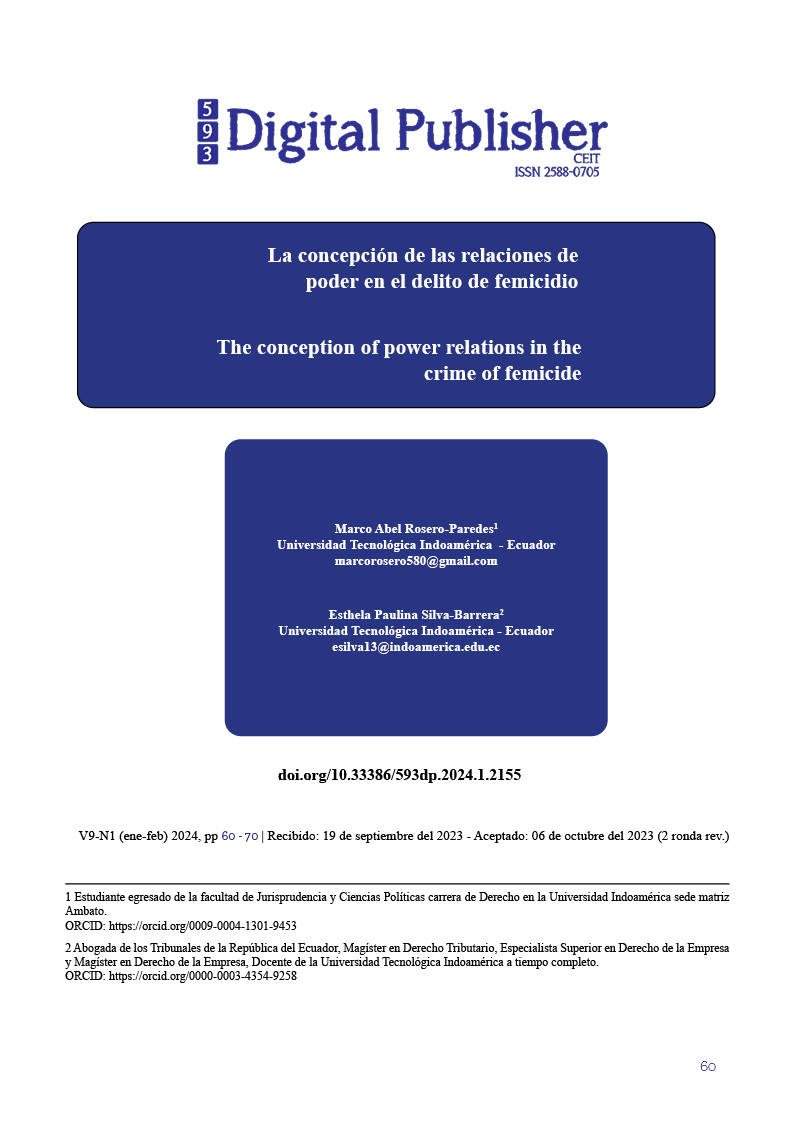The Conception of Power Relations in the Crime of Femicide
Main Article Content
Abstract
Femicide is a serious crime based on gender inequalities rooted in society and that contribute to the perpetuation of violence against women. In Ecuador, as in other countries, power relations play a fundamental role in the context of femicide. The objective of this review is to analyze the conception of power relations in the crime of femicide in Ecuadorian legislation. The methodology used was qualitative in which a bibliographic review was made in the most relevant databases. According to the investigation, the high levels of femicide crimes in Ecuador have led several countries in the region to classify it within their legal bodies. This suggests that, although the criminalization of femicide has contributed to increasing social awareness about murders due to gender violence, there are still challenges regarding a clear classification within the norm, which allows the definition of the crime in terms of power relations, which should also be included within the articles in the COIP (Comprehensive Organic Criminal Code).
Downloads
Article Details

This work is licensed under a Creative Commons Attribution-NonCommercial-ShareAlike 4.0 International License.
1. Derechos de autor
Las obras que se publican en 593 Digital Publisher CEIT están sujetas a los siguientes términos:
1.1. 593 Digital Publisher CEIT, conserva los derechos patrimoniales (copyright) de las obras publicadas, favorece y permite la reutilización de las mismas bajo la licencia Licencia Creative Commons 4.0 de Reconocimiento-NoComercial-CompartirIgual 4.0, por lo cual se pueden copiar, usar, difundir, transmitir y exponer públicamente, siempre que:
1.1.a. Se cite la autoría y fuente original de su publicación (revista, editorial, URL).
1.1.b. No se usen para fines comerciales u onerosos.
1.1.c. Se mencione la existencia y especificaciones de esta licencia de uso.
References
Ávila-Fuenmayor, F. (2006). El concepto de poder en Michel Foucault. Telos. Revista de Estudios Interdisciplinarios En Ciencias Sociales, 8(2), 215–234.
Baker, L., Etherington, N., Pietsch, N., Straatman, A.L., Ansems, A., Barreto E. y Campbell M. (2015). Femicide. Center for Research and Education on Violence on Women and Children. Ontario. 9 pp.
Bălan, S. (2010). M. Foucault’S View on Power Relations. Cogito-Multidisciplinary Research Journal, 1, 1972–1977.
Bernal Sarmiento, C., Lorente Acosta, M., Roth, F., & Zambrano, M. (2014). Latin American Model Protocol for the investigation of gender-related killings of women (femicide/feminicide).
Bernal, C., & Roth, F. (2014). Latin American Model Protocol for the investigation of gender-related killings of women (femicide/feminicide). Regional Office for Central America of the United Nations High Commissioner for Human Rights (OHCHR).
Brugger, S. (2009). From Mexico to Lima Feminicide: A Global Phenomenon? Heinrich Böll Stiftung, Bélgica. 24 pp.
Carcedo, A. y Ordóñez Laclé, C. (2011). El Femicidio en Ecuador. Comisión de Transición Hacia el Consejo de las Mujeres y la Igualdad de Género. Quito. 112 pp.
Carrigan, M., & Dawson, M. (2020). Problem representations of femicide/feminicide legislation in Latin America. International Journal for Crime, Justice, and Social Democracy, 9(2), 1–19. https://doi.org/10.5204/IJCJSD.V9I2.1354
Cesário, J. M. S., Flauzino, V. H. P., y Mejia, J. V. C. (2020). Principais tipos de pesquisas e suas caraterísticas. Revista Científica Multidisciplinar Núcleo Do Conhecimento, 5(11), 23–33. https://www.nucleodoconhecimento.com.br/educacao/tipos-de-
Código Orgánico Integral Penal, Registro Oficial - Órgano del Gobierno del Ecuador 144 (2021).
Convención de Belém do Pará (1994). La Convención Interamericana para Prevenir, Sancionar y Erradicar la Violencia contra la Mujer. Organización de los Estados Americanos. Disponible en: https://www.oas.org/es/mesecvi/docs/Folleto-BelemdoPara-ES-WEB.pdf
Dawson, M., & Carrigan, M. (2021). Identifying femicide locally and globally: Understanding the utility and accessibility of sex/gender-related motives and indicators. Current Sociology, 69(5), 682–704. https://doi.org/10.1177/0011392120946359
García-Moreno, C., Guedes, A. y Knerr, W. (2012). Understanding and addressing violence against women. Organización Mundial de la Salud. Disponible en: https://apps.who.int/iris/bitstream/handle/10665/77421/WHO_RHR_12.38_eng.pdf
Gomes, I. S. (2018). Feminicídios: um longo debate TT - Femicides: a Long Debate. Revista Estudos Feministas, 26(2), 1–16.
Me, A., Yee, S., Mingeirou K. (2022). Gender-related killings of women and girls (femicide/feminicide) Global estimates of gender-related killings of women and girls in the private sphere in 2021 Improving data to improve responses. United Nations Office on Drugs and Crime (UNODC). 48 p. Disponible en: https://www.unodc.org/documents/data-and-analysis/briefs/Femicide_brief_Nov2022.pdf
MESECVI (Committee of Experts of the Follow-up Mechanism to the Belém do Pará Convention). (2008). Declaration on Femicide. Organización de los Estados Americanos, Comisión Interamericana para las Mujeres. Disponible en: https://www.oas.org/es/mesecvi/docs/declaracionfemicidio-en.pdf
Messerschmidt, J. W. (2017). Masculinities and femicide. Qualitative Sociology Review, 13(3), 70–78. https://doi.org/10.18778/1733-8077.13.3.05
Ortiz-Prado, E., Villagran, P., Abarca, A. M., Henríquez, A., Simbaña,-Rivera, K., Gómez-Barreno, L., Díaz, A., Moyano, C., Aecos-Valle, V., Miño, M. D., & Morgan, S. (2022). Female homicides and femicides in Ecuador: a nationwide ecological analysis from 2001 to 2017. BMC Women’s Health, 22(1), 1–14. https://doi.org/10.1186/s12905-022-01839-2
Palacios Moreno, D. M. (2021). El concepto de relación de poder en el delito de femicidio en el Azuay (2014-2020). Universidad Andina Simón Bolívar.
Palacios, D. (2021). El concepto de relación de poder en el delito de femicidio en el Azuay (2014-2020). Tesis de Maestría. Universidad Andina Simón Bolívar, Quito. 85 pp.
Proaño Reyes, G. (2019). Femicidio: una investigación con perspectiva de género. Iuris Dictio, 24: 93-109. DOI 10.18272/iu.v24i24.1457
Saenz, J. E. (2020). Femicidio: como delito violento y circunstanciado. Revista Universidad y Sociedad, 12(4), 325-332.
Sánchez Bracho, M., Fernández, M., y Díaz, J. (2021). Técnicas e instrumentos de recolección de información: análisis y procesamiento realizado por el investigador cualitativo. Revista Científica UISRAEL, 8(1), 107–121. https://doi.org/10.35290/rcui.v8n1.2021.400
UNODC (United Nations Office on Drugs and Crime) (2022). Statistical framework for measuring the gender-related killing of women and girls (also referred to as “femicide/feminicide”). United Nations Entity for Gender Equality and the Empowerment of Women, Viena. Disponible en: https://www.unodc.org/documents/data-and-analysis/statistics/Statistical_framework_femicide_2022.pdf
Velásquez, N. R. P. (2017). Relaciones de poder y subjetividades laborales: Una reflexión desde la perspectiva de Foucault. Revista Iberoamericana de Psicología, 10(1), 93–101.



